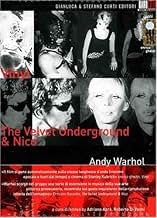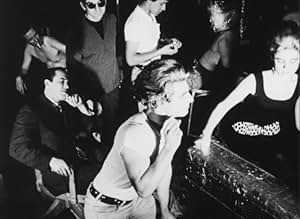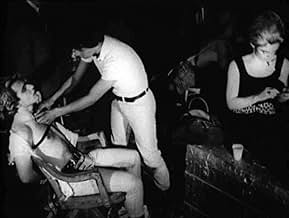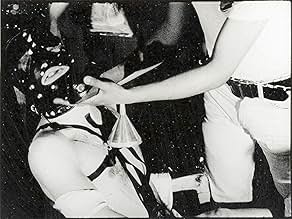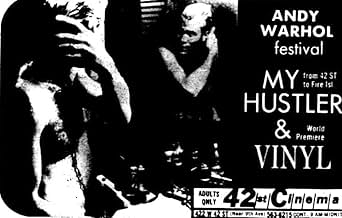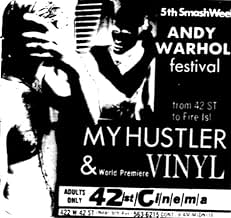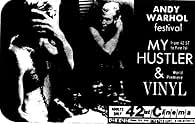Vinyl
- 1965
- 1h 10min
NOTE IMDb
4,2/10
1,2 k
MA NOTE
Ajouter une intrigue dans votre langueWarhol's strange interpretation of "A Clockwork Orange." Includes Gerard dancing to the Martha and the Vandellas classic "Nowhere to Run" and being tortured by professional sadists.Warhol's strange interpretation of "A Clockwork Orange." Includes Gerard dancing to the Martha and the Vandellas classic "Nowhere to Run" and being tortured by professional sadists.Warhol's strange interpretation of "A Clockwork Orange." Includes Gerard dancing to the Martha and the Vandellas classic "Nowhere to Run" and being tortured by professional sadists.
- Réalisation
- Scénario
- Casting principal
Avis à la une
There are bad movies, and there are BAD movies. After 70 agonizing minutes, I realized this is genuinely in the running for worst movie I've ever seen. I can't think of a single redeeming feature, just the bad ones, from the wooden acting, truly unimpressive cinematography and staging, (I'd complain about the editing, but there is none), etc.
Best to just read the book and watch the Kubrick movie.
At this point in my life I have seen worse and stranger films than Andy Warhol's Vinyl, but I cannot say that improved my viewing experience. The film is the pop-artist's interpretation of Anthony Burgess' "A Clockwork Orange" and was made six years before the much more famous Kubrick version. Why is Vinyl not as memorable as the widely known and accepted 70's adaptation? The answer to that question is easy - Warhol's version sucks.
Vinyl does follow the basic story of "A Clockwork Orange". Victor is a troubled youth who is taken in and made subject to a terrible experiment that makes him submissive to violence. If left at this, the movie would have been kind of neat, but poor production quality and significant artistic liberties make this an unusual and uncomfortable experience.
In this film, the camera hardly moves. All of the characters exist is the same small space and world. Warhol's camera is the dictator over what is important, and it never allows the viewer to get a full sense of what is going on. This creates a cramped and almost unwatchable series of events that are sort of explained, yet hardly audible.
The acting is almost laughably bad. The cast is made up of Andy Warhol's Factory regulars, and I would be surprised if any of them knew how to properly play a character. Some names that may shout out to art snobs are Gerard Malanga (in the lead role) and Ondine (as Scum Baby). Watching these "famous" socialite figures bumble through their lines is sometimes hilarious. You can hear voices off screen feeding lines to the actors. If they forget what they are saying they will just stop and move on to the next part. It is unbelievable that Vinyl got as far as it did in production.
But that ties in to what makes Vinyl sort of interesting. This is not a film that was rehearsed ahead of time. The actors did not know their lines or cues or anything before Warhol put the camera on them and shouted action. Heck, it does not even have an opening or ending sequence of credits. All we open and close to is Warhol yelling the names of the cast and crew from off camera.
There is also a very strange homosexual sadist scene around the end of the picture. I cannot confirm or deny whether or not the source material contained any sexual undertones, but Warhol must have seen them in there somewhere. I am not sure why they decided that leather masks and wax burning was the way to go, but I remember the torture scene in the novel to be a bit less...weird.
One positive note about Vinyl is that the audience gets to see the beautiful Edie Sedgwick throughout the entirety of the action. She serves as almost a part of the set. She does not speak, but she smokes and dances and forces the audience to pay attention to her. It is no doubt that Warhol wanted her to be a star. She has a mesmerizing quality about her. Knowing the story of her tragic life and death, it was almost sad to see her first on-screen appearance. She did not look as though she knew what she was getting into with the Factory. Even if she did, she was out of place.
Vinyl is not the least entertaining movie that I have ever seen, but I cannot understand why it has been deemed significant. Yes, an Andy Warhol telling of "A Clockwork Orange" might seem interesting to the everyday moviegoer - but the horrible acting, sound quality and direction makes the whole thing not worth the time.
If this film had been directed by anybody else, I doubt the public would have ever even heard of it. I would have been okay with that. Pop-art and the fifteen seconds of fame may be the good things that Andy Warhol brought to the world, but Vinyl is a bad movie. I would rather look at the soup can for 70 minutes....
Vinyl does follow the basic story of "A Clockwork Orange". Victor is a troubled youth who is taken in and made subject to a terrible experiment that makes him submissive to violence. If left at this, the movie would have been kind of neat, but poor production quality and significant artistic liberties make this an unusual and uncomfortable experience.
In this film, the camera hardly moves. All of the characters exist is the same small space and world. Warhol's camera is the dictator over what is important, and it never allows the viewer to get a full sense of what is going on. This creates a cramped and almost unwatchable series of events that are sort of explained, yet hardly audible.
The acting is almost laughably bad. The cast is made up of Andy Warhol's Factory regulars, and I would be surprised if any of them knew how to properly play a character. Some names that may shout out to art snobs are Gerard Malanga (in the lead role) and Ondine (as Scum Baby). Watching these "famous" socialite figures bumble through their lines is sometimes hilarious. You can hear voices off screen feeding lines to the actors. If they forget what they are saying they will just stop and move on to the next part. It is unbelievable that Vinyl got as far as it did in production.
But that ties in to what makes Vinyl sort of interesting. This is not a film that was rehearsed ahead of time. The actors did not know their lines or cues or anything before Warhol put the camera on them and shouted action. Heck, it does not even have an opening or ending sequence of credits. All we open and close to is Warhol yelling the names of the cast and crew from off camera.
There is also a very strange homosexual sadist scene around the end of the picture. I cannot confirm or deny whether or not the source material contained any sexual undertones, but Warhol must have seen them in there somewhere. I am not sure why they decided that leather masks and wax burning was the way to go, but I remember the torture scene in the novel to be a bit less...weird.
One positive note about Vinyl is that the audience gets to see the beautiful Edie Sedgwick throughout the entirety of the action. She serves as almost a part of the set. She does not speak, but she smokes and dances and forces the audience to pay attention to her. It is no doubt that Warhol wanted her to be a star. She has a mesmerizing quality about her. Knowing the story of her tragic life and death, it was almost sad to see her first on-screen appearance. She did not look as though she knew what she was getting into with the Factory. Even if she did, she was out of place.
Vinyl is not the least entertaining movie that I have ever seen, but I cannot understand why it has been deemed significant. Yes, an Andy Warhol telling of "A Clockwork Orange" might seem interesting to the everyday moviegoer - but the horrible acting, sound quality and direction makes the whole thing not worth the time.
If this film had been directed by anybody else, I doubt the public would have ever even heard of it. I would have been okay with that. Pop-art and the fifteen seconds of fame may be the good things that Andy Warhol brought to the world, but Vinyl is a bad movie. I would rather look at the soup can for 70 minutes....
The brilliance of this movie, is that, Andy Warhol created his version of the greatest film of all time (Clockwork Orange)...SIX YEARS BEFORE the greatest film of all time was even released.
The Opening shot.
The "Old Up Yours."
The Violent "Flickers"
If Kubrick never saw this film...I'd be amazed...
The Opening shot.
The "Old Up Yours."
The Violent "Flickers"
If Kubrick never saw this film...I'd be amazed...
Warhol's adaptation (for lack of a more shambling word) of Anthony Burgess' A CLOCKWORK ORANGE begins with a giant closeup of the glowering droog antihero, then moves backward to reveal him narcissistically preening while a crowd of poshy socialites sits blithely by. If this sounds familiar, it's because it's the same opening Stanley Kubrick designed for his version of the book--except that Warhol, working on a sub-Z budget, could only zoom backward, not track.
VINYL is staged in what seems to be a corner of Andy's Factory loft, where a knot of S&M kidnappers, languid dilettantes, plainclothesmen and JD's act out Burgess' fable of a thug's "cure" through mind control. The moralizing of Burgess' novel gets instantly burned away in the wake of a kooky combination of elegant minimalist mise-en-scene, rough-trade heavy breathing, and the usual Warholian giggling at seemingly blithe freaks and damaged goods
Some of the picture lags under the burden of Ronald Tavel's clunky sixties-off-Broadway writing, but the first sequence is sheer amazement--climaxing with the droog Gerard Malanga's motto-delivering monologue (a pinnacle among Warhol is-this-supposed-to-be-bad? scenes) and his nutty chicken dance to Martha and the Vandellas' "Nowhere to Hide"--played all the way through, twice. (The start-up of rendition #2 gets the movie's biggest laugh.)
As always in Warhol, the stasis of the image gives the picture the feeling of a window onto eternity. And the combination of extreme glamour and fox-in-the-henhouse cruelty, framed in compositions that recall heads in a vise, suggests the excitement this work must have had for an ambitious young Bavarian actor-playwright named Rainer Werner Fassbinder.
VINYL is staged in what seems to be a corner of Andy's Factory loft, where a knot of S&M kidnappers, languid dilettantes, plainclothesmen and JD's act out Burgess' fable of a thug's "cure" through mind control. The moralizing of Burgess' novel gets instantly burned away in the wake of a kooky combination of elegant minimalist mise-en-scene, rough-trade heavy breathing, and the usual Warholian giggling at seemingly blithe freaks and damaged goods
Some of the picture lags under the burden of Ronald Tavel's clunky sixties-off-Broadway writing, but the first sequence is sheer amazement--climaxing with the droog Gerard Malanga's motto-delivering monologue (a pinnacle among Warhol is-this-supposed-to-be-bad? scenes) and his nutty chicken dance to Martha and the Vandellas' "Nowhere to Hide"--played all the way through, twice. (The start-up of rendition #2 gets the movie's biggest laugh.)
As always in Warhol, the stasis of the image gives the picture the feeling of a window onto eternity. And the combination of extreme glamour and fox-in-the-henhouse cruelty, framed in compositions that recall heads in a vise, suggests the excitement this work must have had for an ambitious young Bavarian actor-playwright named Rainer Werner Fassbinder.
"Vinyl" was the 1965 experimental film by, none other than, Andy Warhol himself. This is a crude adaptation of the classic Anthony Burgess novel "A Clockwork Orange".
I wasn't expecting a groundbreaking performance when I put the movie on to watch, as you'd probably know if you've seen such classic Warhol films as "Poor Little Rich Girl" and especially "Sleep". But Warhol films can be fun if you have a lot of patience, as I had very little to begin with (I lasted about 30 minutes before I started getting antsy for the film to end). I won't give too much of the plot away but I can tell you that it has it's moments, such as the name-calling, the candle wax being poured on the protagonist's chest, and the awful acting (or improv apparently).
In short I believe any Warhol fan would like this film. My advice to the people is give it a shot if your a movie lover, just to say you watched it (or tried to), but if you have no patience for these kind of movies then this may not be your cup of tea.
I wasn't expecting a groundbreaking performance when I put the movie on to watch, as you'd probably know if you've seen such classic Warhol films as "Poor Little Rich Girl" and especially "Sleep". But Warhol films can be fun if you have a lot of patience, as I had very little to begin with (I lasted about 30 minutes before I started getting antsy for the film to end). I won't give too much of the plot away but I can tell you that it has it's moments, such as the name-calling, the candle wax being poured on the protagonist's chest, and the awful acting (or improv apparently).
In short I believe any Warhol fan would like this film. My advice to the people is give it a shot if your a movie lover, just to say you watched it (or tried to), but if you have no patience for these kind of movies then this may not be your cup of tea.
Le saviez-vous
- AnecdotesIncluded among the "1001 Movies You Must See Before You Die", edited by Steven Schneider.
- ConnexionsFeatured in Exploding Plastic Inevitable (1967)
- Bandes originalesNowhere to Run
Written by Lamont Dozier, Brian Holland and Eddie Holland
Performed by Martha & The Vandellas
Meilleurs choix
Connectez-vous pour évaluer et suivre la liste de favoris afin de recevoir des recommandations personnalisées
- How long is Vinyl?Alimenté par Alexa
Détails
- Durée
- 1h 10min(70 min)
- Couleur
- Mixage
Contribuer à cette page
Suggérer une modification ou ajouter du contenu manquant

